ENPP3(CD203c):ENPPs核苷酸代谢胞外酶,能量代谢调控者、变态反应标记物、肾癌RCC治疗在研靶点!
日期:2023-09-20 13:54:04
最近,美国Xencor公司推出临床药物AGS-16M8F12(ENPP3 x CD3),一款针对ENPP3的双特异性抗体药物,旨在评估其在转移性肾细胞癌(RCC)患者中的安全性、药代动力学和推荐剂量。膜外核苷酸焦磷酸酯酶/磷酸二酯酶(ENPPs)家族是近年备受研究者关注的一类胞外酶。ENPP1已有广泛文献和临床研究,相比之下,ENPP3的国内外研究报道较为有限。然而,陆续的研究成果逐渐揭示ENPP3在能量代谢和变态反应等生理过程中具有重要作用。特别是在肿瘤治疗领域,靶向ENPP3已展现出巨大潜力。因此,深入研究ENPP3可能揭示新的生理机制,为相关疾病的诊断和治疗提供创新性方法!
1. 什么是膜外核苷酸焦磷酸酯酶/磷酸二酯酶家族(ENPPs)?
膜外核苷酸焦磷酸酯酶/磷酸二酯酶家族(Ecto-nucleotide pyrophosphatase/phosphodiesterase, E-NPPs/ENPPs)是一组在哺乳动物体内具有相似结构的膜蛋白。目前共发现该家族的7个成员(ENPP1~ENPP7)。该家族名称的由来是因为最初发现的ENPP1、ENPP2、ENPP3均具有水解核苷酸及其衍生物的焦磷酸酯键/磷酸二酯键的活性。而进一步的研究表明,ENPPs的一些成员还具有重要的磷脂酶活性。ENPP4、ENPP5、ENPP6则是在大规模测序时发现的未知功能蛋白,根据其与ENPPs的结构同源性而将其列入该家族。近几年来,有关ENPPs在多种生理病理过程中复杂机制的研究已取得很大进展,它们参与的很多病理过程与其胞外作用有关,这使得它们成为治疗相关疾病的潜在靶标 [1-3]。
2. 什么是ENPP3?
2.1 ENPP3的结构
ENPP3(又名CD203c或NPP3)属于膜外核苷酸焦磷酸酯酶/磷酸二酯酶家族蛋白成员(ENPPs)。ENPP3最初被命名为Gp130RB13-6,它可以识别一类中度表达的酸性神经胶质纤维蛋白亚类,这类蛋白通常存在于大鼠神经胶质母细胞中。ENPP3基因位于人类染色体6q23.2-q23.3区域。ENPPs的氨基酸序列具有较高的同源性,目前研究较为清楚的NPP1、NPP2、NPP3属于一个亚家族,它们是Ⅱ型膜蛋白,这3个成员均含有一个短的细胞内N端、单一的穿膜区和1个较长的胞外区,胞外区包含有2个生长调节素B样结构域、1个保守的磷酸二酯酶样催化结构域、1个核酸酶样序列和1个EF-手象的Ca2+结合模体 (图1)[5-6]。
2.2 ENPP3的表达和功能
ENPP3在人体的前列腺、子宫、结肠、嗜碱性粒细胞、肥大细胞、祖细胞,以及某些肿瘤中表达。虽然在人的肝脏、胰腺和肠道中未检测到ENPP3的表达,但在大鼠的这些组织中均已发现。ENPPs这些酶的核苷酸底物可以触发P2X离子通道受体/P2X嘌呤受体(如P2RX1、P2RX2、P2RX3、P2RX4、P2RX5、P2RX6、P2RX7)和某些G蛋白偶联受体/P2Y嘌呤受体(如P2RY1、P2RY2、P2RY3、P2RY4、P2RY5、P2RY6、P2RY7、P2RY8, etc.)。这些P2X和P2Y受体家族在许多生理和病理过程中发挥关键作用 [7-10]。
ENPP3作为调节嘌呤代谢的胞外酶,其关键功能之一是抑制肥大细胞和嗜碱性粒细胞在慢性炎症和过敏反应中的活性。值得注意的是,也有研究认为ENPP3与人类多种癌症的发病可能存在关联,尤其是肾细胞癌。尽管在国内报道非常少,但国外的研究陆续证明ENPP3与过敏反应和肿瘤的发生发展密切相关。因此,ENPP3有望成为多种过敏反应的诊断标志物或肿瘤治疗的重要靶点 [7-10]!
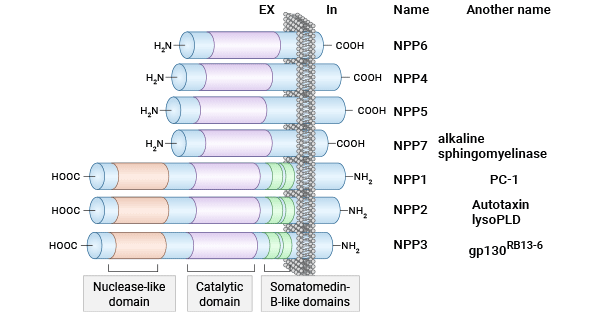
图1. ENPP3的结构 [6]
3. ENPP3相关的信号机制
3.1 ENPP3在能量代谢中的机制
ENPPs作为一种能够水解细胞外核苷酸的酶,在能量代谢和细胞外信号传导方面扮演着重要的角色。一项研究通过动力学分析揭示了ENPP3抑制GnT-IX(GnT-Vb)的机制。GnT-IX是一种糖基转移酶,在糖基化(glycosylation)过程中发挥重要作用。GnT-IX(GnT-Vb)酶在进行糖基化反应时需要使用UDP-GlcNAc这个底物。UDP-GlcNAc提供了所需的糖分子GlcNAc,这些分子将被GnT-IX(GnT-Vb)酶转移到其他分子上,形成复杂的糖链结构,从而影响蛋白质稳定性、细胞识别、信号传导和细胞黏附等多个生物学过程 [12]。
然而,在研究中发现,ENPP3酶可将UDP-GlcNAc分解为UMP(尿苷酸单磷酸)。当UMP与UDP-GlcNAc竞争性结合GnT-IX(GnT-Vb)时,UMP会占据GnT-IX(GnT-Vb)酶需要使用的底物位置。这意味着,GnT-IX(GnT-Vb)不再能够有效地与UDP-GlcNAc结合。因此,ENPP3通过分解UDP-GlcNAc,使得GnT-IX(GnT-Vb)酶的活性降低 (图2) [12]。

图2. ENPP3介导的UDP-GlcNAc水解 [12]
3.2 ENPP3在变态反应中的机制
FcεRI(IgE Fc受体,Fc epsilon receptor I)是一种免疫受体,主要功能是介导变态反应。FcεRI与免疫球蛋白E(IgE)分子相互作用,并在特定类型的免疫细胞上表达,主要包括嗜碱性粒细胞(basophils)和肥大细胞(mast cells) [13]。当FcεRI交联可引发即时或慢性过敏性炎症,然而其具体机制仍然不清楚。
有关研究发现,FcεRI交联引发的ENPP3表达在慢性过敏性炎症中起关键作用。在ENPP3基因缺陷小鼠中,嗜碱性粒细胞和肥大细胞增多,血液中的三磷酸腺苷(ATP,Adenosine Triphosphate)浓度增高,使得它们更容易患慢性过敏性疾病。此外,FcεRI交联会导致这些细胞释放ATP,但在ENPP3−/−的细胞中,ATP清除能力减弱,导致ATP在细胞内积聚,触发过敏性炎症。因此,ENPP3可以减少ATP浓度并降低嗜碱性粒细胞和肥大细胞的活性,以抑制过敏性炎症(图3) [14]。
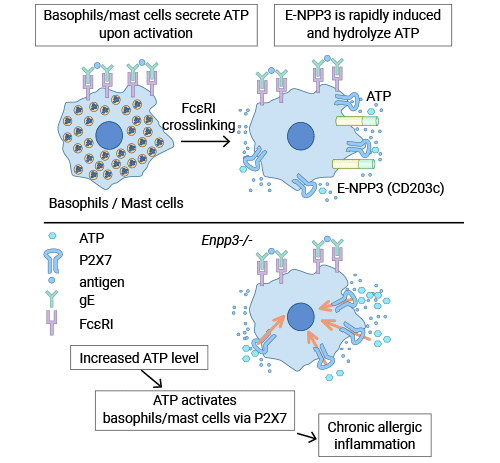
图3. ENPP3抑制依赖于ATP的过敏性炎症 [14]
4. ENPP3在各种过敏和肿瘤等疾病中的作用
4.1 ENPP3与过敏
4.1.1 嗜碱粒细胞ENPP3与过敏
嗜碱粒细胞和肥大细胞是参与变态反应的重要细胞。由于肥大细胞存在于组织中,而嗜碱粒细胞存在于血液循环中,因此,嗜碱粒细胞成为近年体外研究变态反应的突破点。CD63和ENPP3(CD203c)是目前发现嗜碱性粒细胞灵敏度和特异性最高的表面活化标记物 [15-16]。
研究发现,激活状态下,嗜碱粒细胞的ENPP3(CD203c)表达明显上升,其诊断特异度和灵敏度高于CD63。过敏性哮喘患者在粉尘螨刺激后,嗜碱粒细胞的CD203c和CD63荧光强度显著增加 [17];在乳胶和昆虫毒液过敏的诊断中,检测CD203c与CD63同样可靠,但对于蜜蜂和黄蜂过敏患者,CD203c的灵敏度更高 [18-20];坚果过敏患者接受奥马珠单抗(Omalizumab)治疗后,嗜碱粒细胞的CD203c表达水平降低,表明奥马珠通过阻断IgE与嗜碱性粒细胞表面受体(FcεRI)结合来抑制嗜碱性粒细胞的活化 [21]。
另有研究发现,通过使用CRTH2-FlTC、CD203c-PE和CD3-Per-CP这三种抗体,可以检测嗜碱粒细胞表面的ENPP3(CD203c)表达水平,从而判断荨麻疹患者的血清是否能激活嗜碱粒细胞 [22]。荨麻疹患者的血液中存在自身抗体,导致组胺释放活性增加,其中大多数抗体是针对高亲和力IgE受体(FceRl)的自身抗体,也有少数是针对IgE或其他抗体的。这些研究有助于我们了解慢性荨麻疹的发病机制。总的来说,ENPP3(CD203c)在不同过敏性疾病的诊断和治疗中具有重要的潜力。
4.1.2 肥大细胞ENPP3与过敏
肥大细胞表达ENPP3(CD203c)分子,这一发现较晚引起关注。相关研究揭示,人脐带血来源的CD34+造血干细胞培养的肥大细胞和人胃肠道中的肥大细胞都有ENPP3(CD203c) [23-24]。此外,肥大细胞增多症患者的肥大细胞,CD203c表达上调 [23-24]。因此,ENPP3(CD203c)可能是诊断肥大细胞相关疾病的标志物。
相关研究还发现,抗肿瘤药物米哚妥林(Midostaurin)能够抑制人脐带血来源的肥大细胞和人血液中嗜碱性粒细胞释放介质,但不能抑制嗜碱性粒细胞上IgE依赖的ENPP3(CD203c)上调。此外,IgE交联会使肥大细胞增多症患者的肥大细胞CD203e上调,但不影响干细胞因子(SCF)水平 [25-27]。此外,一氧化碳释放分子CORM-3有强大的抗炎作用,但也会促进肥大细胞组胺释放和ENPP3(CD203c)表达 [28-29]。
4.2 ENPP3与肿瘤
ENPP3被认为是一种肿瘤标志物,尤其在肾细胞癌(RCC)领域得到较多关注。在RCC中,ENPP3的表达明显升高,使其成为新型抗体药物偶联物(ADC)的潜在治疗靶标。这些ADC药物研究包括AGS-16M8F和AGS-16C3F,它们结合了抗ENPP3抗体和毒性有效成分MMAF,能够特异性地识别和摧毁RCC细胞,同时表现出持久的抗肿瘤活性和可控的不良反应。因此,探索新一代抗ENPP3抗体ADC药物,可能为治疗转移性肾细胞癌提供新的治疗途径 [30]。
在卵巢癌中,有研究提示,卵巢子宫内膜异位瘤中胞外酶ADA、ALP、ENPP1和ENPP3可作为子宫内膜异位症的候选生物标志物 [31]。在结肠癌细胞中,ENPP3高表达,且与肿瘤细胞的发生和转移有关 [32-33]。虽然ENPP3在多种癌症中起着重要作用,但关于抑制ENPP3的药物研究很有限。现有的抑制剂大多是核苷酸衍生物,但它们在人体内的表现不符合药物应有的性质(如吸收、分布和排泄),因为它们可以在体内分解并产生一些可能对嘌呤受体产生影响的代谢产物,而不是如预期般有效地抑制ENPP3酶的活性。因此,需要进一步研究ENPP3在肿瘤中的机制,以寻找更有效的抑制剂 [34-35]。
4.3 ENPP3与其它疾病
ENPPs异常表达可能导致骨质矿化异常以及其他代谢性疾病的发生。例如,增加1,25(OH)2D水平可能通过维生素D受体(Vitamin D Receptor,VDR)在成熟成骨细胞和/或骨细胞上的作用,提高局部骨质矿化抑制因子(如Enpp1、Enpp3和Ank)的水平 [36];ENPP3和GRIA2之间存在直接的物理相互作用,可能影响血管平滑肌细胞(Vascular Smooth Muscle Cells,VSMCs)的钙信号和MAPK信号传递 [37]。
此外,在皮球囊扩张血管成形术(Percutaneous Transluminal Angioplasty,PTA)术后的动脉中,ENPP3和GRIA2的表达水平显著上升,与再狭窄的严重程度相关 [37]。ENPP3还参与调节呼吸道上皮的液体平衡,可能在肝脏中调节胆汁的形成和脑脊液的分泌。胆汁在肝脏中的形成和排泄对脂质代谢和胰岛素敏感性等方面都具有重要影响。因此,针对ENPP3抑制剂的研发可能有助于预防糖尿病 [38]。
5. ENPP3的临床研究前景
ENPP3是一种广泛参与核苷酸循环、磷脂信号调控、细胞运动和细胞增殖等多种生理过程的分子,其在变态反应疾病和肿瘤中的作用和价值正受到越来越多的关注。目前,已有一种靶向ENPP3的ADC抗体药物AGS-16M8F正在进行I期临床试验,用于治疗转移性肾细胞癌(RCC),目前尚未公布临床结果。此外,ENPP3(CD203c)标记的嗜碱性粒细胞激发试验处于广泛的临床验证阶段。与CD63一样,CD203c标记的嗜碱性粒细胞激发试验或可用于诊断慢性荨麻疹以及食物过敏等变态反应疾病。因此,ENPP3在变态反应疾病领域以及肾癌等肿瘤中的研究颇具前景,可能为相关患者带来新的治疗选择和机会。
为鼎力协助科研和药企人员针对ENPP3在能量代谢、变态反应、肿瘤相关疾病中的临床应用研究,CUSABIO推出ENPP3活性蛋白(CSB-MP4278MOV; CSB-MP007681HU),助力您在ENPP3机制方面的研究或其潜在临床价值的探索。
j9九游会登录入口首页CUSABIO ENPP3 蛋白
● Recombinant Macaca fascicularis ENPP3, partial (Active)
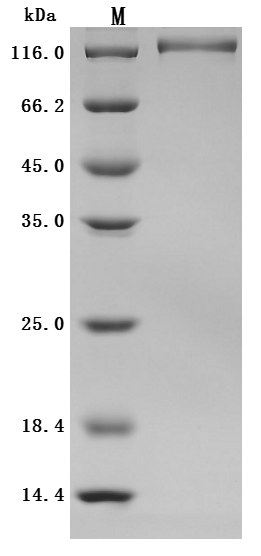
The high purity is greater than 95% as determined by SDS-PAGE.

Immobilized Macaca fascicularis ENPP3 at 2 μg/ml can bind Anti-ENPP3 recombinant antibody (CSB-RA007681MA1HU), the EC50 is 3.313-4.724 ng/mL.
● Recombinant Human ENPP3, partial (Active)
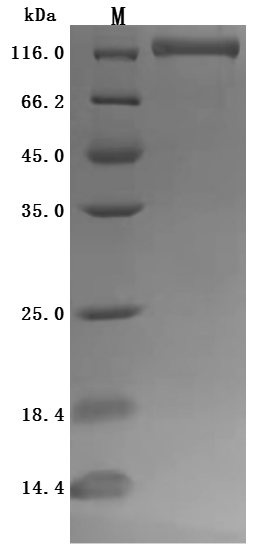
The high purity is greater than 95% as determined by SDS-PAGE.

Immobilized Human ENPP3 at 2 μg/ml can bind anti-ENPP3 recombinant antibody (CSB-RA007681MA1HU), the EC50 is 2.151-2.492 ng/mL.
j9九游会登录入口首页CUSABIO ENPP3 抗体
ENPP3 Recombinant Monoclonal Antibody
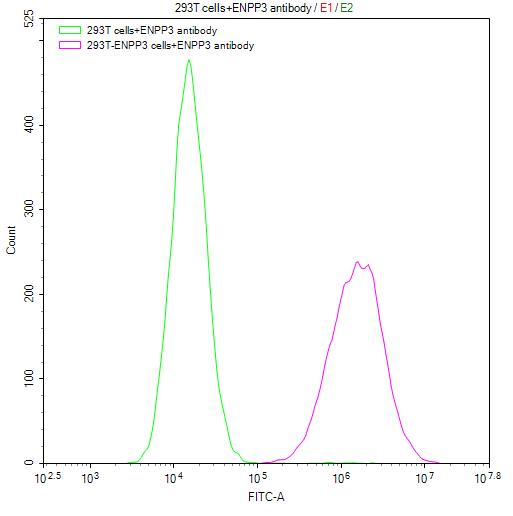
Untransfected and transfected HEK293T cells were stained with anti-ENPP3 antibody and analyzed using flow cytometry with FITC-labeled anti-Human IgG Fc antibody.
j9九游会登录入口首页CUSABIO ENPP3 稳定细胞系
HEK293T/Human ENPP3 Stable Cell Line

Untransfected and transfected HEK293T cells were stained with anti-ENPP3 antibody and analyzed using flow cytometry with FITC-labeled anti-Human IgG Fc antibody.
参考文献:
[1] Fürstenau, Cristina Ribas, et al. "Ecto-nucleotide pyrophosphatase/phosphodiesterase as part of a multiple system for nucleotide hydrolysis by platelets from rats: kinetic characterization and biochemical properties." Platelets 17.2 (2006): 84-91.
[2] Iqbal, Jamshed. "Ectonucleotidases: potential target in drug discovery and development." Mini Reviews in Medicinal Chemistry 19.11 (2019): 866-869.
[3] Stella, Joséli, et al. "Differential ectonucleotidase expression in human bladder cancer cell lines." Urologic Oncology: Seminars and Original Investigations. vol. 28. no. 3. Elsevier, 2010.
[4] Bollen, Mathieu, et al. "Nucleotide pyrophosphatases/phosphodiesterases on the move." Critical reviews in biochemistry and molecular biology 35.6 ( 2000): 393-432.
[5] Ferrero, Enza, Angelo C. Faini, and Fabio Malavasi. "A phylogenetic view of the leukocyte ectonucleotidases." Immunology Letters 205 (2019): 51-58.
[6] Sakagami, Hideki, et al. "Biochemical and molecular characterization of a novel choline-specific glycerophosphodiester phosphodiesterase belonging to the nucleotide pyrophosphatase/phosphodiesterase family." Journal of Biological Chemistry 280.24 (2005): 23084-23093.
[7] Orriss, Isabel R., et al. "The regulation of osteoblast function and bone mineralization by extracellular nucleotides: the role of p2x receptors." Bone 51.3 (2012): 389-400.
[8] Vollmayer, Petra, et al. "Hydrolysis of diadenosine polyphosphates by nucleotide pyrophosphatases/phosphodiesterases." European journal of biochemistry 270.14 (2003): 2971-2978.
[9] Borza, Razvan, et al. "Structure and function of the ecto-nucleotide pyrophosphatase/phosphodiesterase (ENPP) family: tidying up diversity." Journal of Biological Chemistry 298.2 (2022).
[10] Goding, James W., Bert Grobben, and Herman Slegers. "Physiological and pathophysiological functions of the ecto-nucleotide pyrophosphatase/ phosphodiesterase family." Biochimica et Biophysica Acta (BBA)-Molecular Basis of Disease 1638.1 (2003): 1-19.
[11] Korekane, Hiroaki, et al. "Identification of ectonucleotide pyrophosphatase/phosphodiesterase 3 (ENPP3) as a regulator of N- acetylglucosaminyltransferase GnT-IX (GnT-Vb)." Journal of Biological Chemistry 288.39 (2013): 27912-27926.
[12] Taniguchi, Naoyuki, et al. "Identification of ectonucleotide pyrophosphatase/phosphodiesterase 3 as a new modifier of glycan biosynthesis (788.3). " The FASEB Journal 28 (2014): 788-3.
[13] Stone, Kelly D., Calman Prussin, and Dean D. Metcalfe. "IgE, mast cells, basophils, and eosinophils. "Journal of Allergy and Clinical Immunology 125.2 ( 2010): S73-S80.
[14] Tsai, Shih Han, et al. "The ectoenzyme E-NPP3 negatively regulates ATP-dependent chronic allergic responses by basophils and mast cells." Immunity 42.2 (2015): 279-293.
[15] Lourenço, F. D., et al. "Activated status of basophils in chronic urticaria leads to interleukin-3 hyper-responsiveness and enhancement of histamine release induced by anti-IgE stimulus." British Journal of Dermatology 158.5 (2008): 979-986.
[16] Bühring, Hans-Jörg, Anna Streble, and Peter Valent. "The basophil-specific ectoenzyme E-NPP3 (CD203c) as a marker for cell activation and allergy diagnosis." International archives of allergy and immunology 133.4 (2004): 317-329.
[17] Ono, Emiko, et al. "CD203c expression on human basophils is associated with asthma exacerbation." Journal of allergy and clinical immunology 125.2 (2010): 483-489.
[18] Eberlein-König, B., et al. "Comparison of basophil activation tests using CD63 or CD203c expression in patients with insect venom allergy ." Allergy 61.9 (2006): 1084-1085.
[19] Bühring, Hans-Jörg, Anna Streble, and Peter Valent. "The basophil-specific ectoenzyme E-NPP3 (CD203c) as a marker for cell activation and allergy diagnosis." International archives of allergy and immunology 133.4 (2004): 317-329.
[20] Mikkelsen, Susan, et al. "Basophil sensitivity through CD63 or CD203c is a functional measure for specific immunotherapy." Clinical and Molecular Allergy 8 (2010): 1-9.
[21] Oda, Yoshiko, et al. "Improved FcεRI-mediated CD203c basophil responsiveness reflects rapid responses to omalizumab in chronic spontaneous urticaria." The Journal of Allergy and Clinical Immunology: In Practice 9.3 (2021): 1166-1176.
[22] Eberlein, Bernadette, et al. "Optimizing of the basophil activation test: comparison of different basophil identification markers." Cytometry Part B : Clinical Cytometry 88.3 (2015): 183-189.
[23] Reimer, J. M., et al. "Isolation of transcriptionally active umbilical cord blood-derived basophils expressing FcɛRI, HLA -DR and CD203c." Allergy 61.9 (2006): 1063-1070.
[24] Hauswirth, A. W., et al. "CD203c is overexpressed on neoplastic mast cells in systemic mastocytosis and is upregulated upon IgE receptor cross-linking. " International journal of immunopathology and pharmacology 21.4 (2008): 797-806.
[25] Kambe, Naotomo, et al. "Development of both human connective tissue-type and mucosal-type mast cells in mice from hematopoietic stem cells with identical distribution pattern to human body." Blood 103.3 (2004): 860-867.
[26] Krauth M T, Mirkina I, Herrmann H, et al. Midostaurin (PKC412) inhibits immunoglobulin E-dependent activation and mediator release in human blood basophils and mast cells[J]. Clinical & Experimental Allergy, 2009, 39(11): 1711-1720.
[27] Takagi, Shinsuke, et al. "Membrane-bound human SCF/KL promotes in vivo human hematopoietic engraftment and myeloid differentiation." Blood, The Journal of the American Society of Hematology 119.12 (2012): 2768-2777.
[28] Masini E, Vannacci A, Failli P, et al. A carbon monoxide-releasing molecule (CORM-3) abrogates polymorphonuclear granulocyte-induced activation of endothelial cells and mast cells[J]. The FASEB Journal, 2008, 22(9): 3380-3388.
[29] Vannacci A, Giannini L, Fabrizi F, et al. Effects of the carbon monoxide releasing molecule CORM-3 in a coincubation model of rat mast cells with human neutrophils[J]. Inflammation Research, 2007, 56: S13-S14.
[30] Doñate F, Raitano A, Morrison K, et al. AGS16F is a novel antibody drug conjugate directed against ENPP3 for the treatment of renal cell carcinoma[J]. Clinical Cancer Research, 2016, 22(8): 1989-1999.
[31] Trapero C, Jover L, Fernández-Montolí M E, et al. Analysis of the ectoenzymes ADA, ALP, ENPP1, and ENPP3, in the contents of ovarian endometriomas as candidate biomarkers of endometriosis[J]. American Journal of Reproductive Immunology, 2018, 79(2): e12794.
[32] Chen L, Pan X, Hu X H, et al. G ene expression differences among different msi statuses in colorectal cancer[J]. International journal of cancer, 2018, 143(7): 1731-1740.
[33] Li J, Mo Y, Wei Q, et al. High Infiltration of CD203c+ Mast Cells Reflects Immunosuppression and Hinders Prognostic Benefit in Stage II-III Colorectal Cancer[J]. Journal of Inflammation Research, 2023: 723-735.
[34] Ullah S, El-Gamal M I, Zaib S, et al. Synthesis, biological evaluation, and docking studies of new pyrazole-based thiourea and sulfonamide derivatives as inhibitors of nucleotide pyrophosphatase/phosphodiesterase[J]. Bioorganic Chemistry, 2020, 99: 103783.
[35] Ullah S, El-Gamal M I, El-Gamal R, et al. Synthesis, biological evaluation, and docking studies of novel pyrrolo [2, 3-b] pyridine derivatives as both ectonucleotide pyrophosphatase/phosphodiesterase inhibitors and antiproliferative agents[J]. European Journal of Medicinal Chemistry, 2021, 217: 113339.
[36] Goltzman D. Inferences from genetically modified mouse models on the skeletal actions of vitamin D[J]. The Journal of Steroid Biochemistry and Molecular Biology, 2015, 148: 219-224.
[37] Zhou M, Qi L, Gu Y. GRIA2/ENPP3 regulates the proliferation and migration of vascular smooth muscle cells in the restenosis process Post-PTA in lower extremity arteries[J]. Frontiers in Physiology, 2021, 12: 712400.
[38] Ullah S, Pelletier J, Sévigny J, et al. Synthesis and Biological Evaluation of Arylamide Sulphonate Derivatives as Ectonucleotide Pyrophosphatase/ Phosphodiesterase-1 and-3 Inhibitors[J]. ACS omega, 2022, 7(30): 26905-26918.












